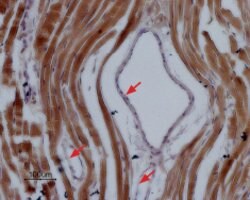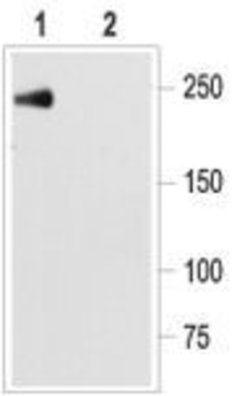Learn More
SCN5A Polyclonal Antibody, Invitrogen™
Rabbit Polyclonal Antibody
Supplier: Thermo Scientific PA5111903
Description
Reconstitute antibody with 50 μL of double distilled water (DDW). The reconstituted solution can be stored at 4 degrees C for up to 1 week. For longer periods, small aliquots should be stored at -20 degrees C. Avoid multiple freezing and thawing. Centrifuge all antibody preparations before use (10000 x g 5 min). Homology: Rat - 36/39 amino acid residues identical; mouse - 34/39 amino acid residues identical.
Scn5a is an integral membrane protein and tetrodotoxin-resistant voltage-gated sodium channel subunit. Scn5a is found primarily in cardiac muscle and is responsible for the initial upstroke of the action potential in an electrocardiogram. Defects in Scn5a are a cause of long QT syndrome type 3 (LQT3), an autosomal dominant cardiac disease. Alternative splicing results in several transcript variants encoding different isoforms of Scn5a. Voltage-gated sodium channesl (VGSCs) mediate regenerative cell membrane depolarization and conduction of electrical signalling in nerves and muscles. Expression of Scn5a is also detected in lymphocytes, glia, and fibroblasts. Further, Scn5a mediates the voltage-dependent sodium ion permeability of excitable membranes. Assuming opened or closed conformations in response to the voltage difference across the membrane, Scn5a forms a sodium-selective channel through which Na(+) ions may pass in accordance with their electrochemical gradient. Functionally, Scn5a is responsible for the initial upstroke of the action potential and the channel inactivation is regulated by intracellular calcium levels. Voltage-gated sodium channels (NaV) are responsible for action potential initiation and propagation in excitable cells, including nerve, muscle, and neuroendocrine cell types. Scn5a are also expressed at low levels in non-excitable cells, where their physiological role is unclear. Diseases associated with SCN5A include Long Qt Syndrome-3 and Brugada Syndrome 1.
Specifications
| SCN5A | |
| Polyclonal | |
| Unconjugated | |
| SCN5A | |
| CDCD2; CDCD2VF1; CIN5; CMD1E; CMPD2; HB1; HB2; HBBD; HH1; HH1CMD1E; ICCD; IVF; LQT3; LQT3SSS1CMPD2; mH1; Nav1.5; Nav1.5c; PFHB1; RATRSKM2X; RH1; RSkM2; RSKM2X; SCAL; Scn2x; SCN5A; SkM1; SkM2; Sodium channel protein cardiac muscle subunit alpha; Sodium channel protein type 5 subunit alpha; Sodium channel protein type V subunit alpha; SSS1; VF1; Voltage-gated sodium channel subunit alpha Nav1.5 | |
| Rabbit | |
| Antigen affinity chromatography | |
| RUO | |
| 25665, 6331 | |
| -20°C | |
| Lyophilized |
| Flow Cytometry, Immunocytochemistry, Immunofluorescence, Immunohistochemistry (Paraffin), Western Blot | |
| 0.95 mg/mL | |
| PBS with 1% BSA and 0.05% sodium azide; pH 7.4 | |
| P15389, Q14524 | |
| SCN5A | |
| GSTfusion protein with amino acid residues 1978-2016 of human NaV1.5 (Intracellular, C-terminus) | |
| 50 μL | |
| Primary | |
| Human, Rat | |
| Antibody | |
| IgG |
Your input is important to us. Please complete this form to provide feedback related to the content on this product.

